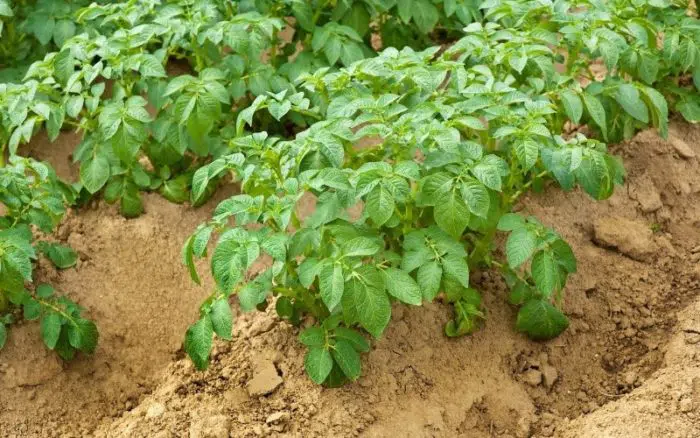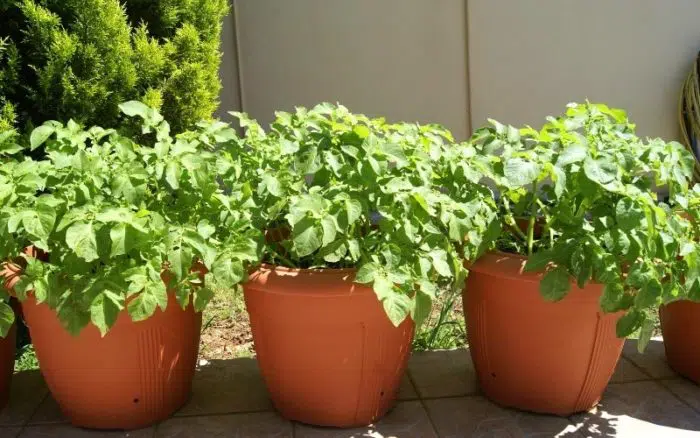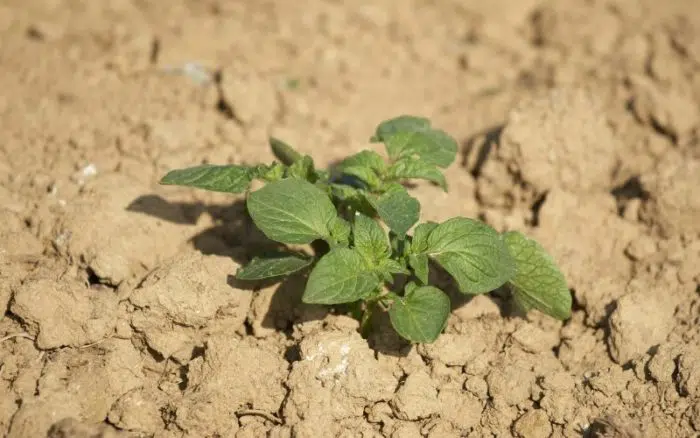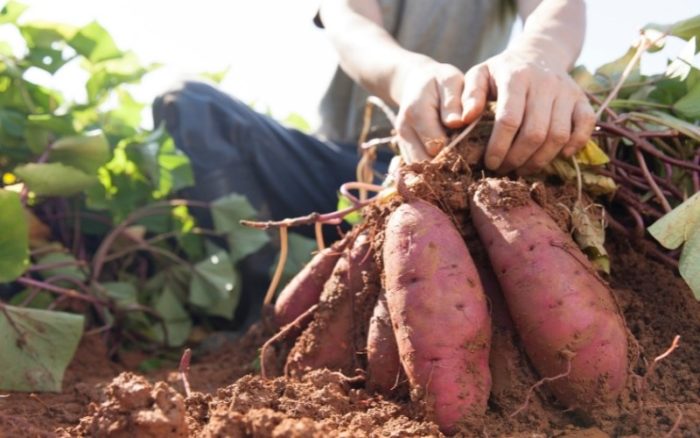Being able to harvest potatoes was one of my favorite things to come out of the garden last year. There is just something about being able to eat homegrown potatoes that is so rewarding.
But one of the most important aspects, and sometimes the trickiest part of growing potatoes is knowing how often to water them. You can’t see most of the plant, so it’s hard to tell if they’re thirsty or not. Let’s walk through some good ways to avoid poor watering practices and start planting potatoes the right way.
How Often to Water Potatoes
Watering frequency for potatoes can vary depending on a number of factors, including the type of potato you are growing, the stage of growth it’s in, the climate, and the amount of rainfall you’re expecting.
In general, potato plants need about 1 to 1.5 inches of water per week under normal conditions. If the soil is sandy or light in texture, watering more often may be necessary as it won’t hold much moisture; if the soil contains a lot of clay that keeps the soil moist, watering less often may be necessary.
Potato plants in garden beds or raised beds require different amounts of water than those in pots and grow bags.
Growing Potatoes in Raised Beds and the Ground
When you grow potatoes in raised beds or in garden beds, you usually will need to water every few days unless it’s really hot outside, in which case you can expect to water more frequently. Depending on which zone you live in, your potatoes might see a lot more rain, in which can you can pull back the watering frequency a bit and let Mother Nature do her thing.
Depending on what stage your plants at, they have different water requirements.
- Young potato plants will need to be watered more often than mature plants. Checking on them daily is a good idea for the first few weeks of growth.
- More mature, full grow potato plants tend to be a bit hardier and require less water.

Add Mulch to Your Garden
Because potatoes do best when grown under hills, you can save yourself a lot of hassle by adding mulch around the plants as they grow. This can come in the form of cedar mulch, grass clippings, leaf mulch, compost, and other organic materials you might find around the garden.
This helps reduce water evaporation and keeps the soil surrounding the plant from getting too hot, which can cause your plants to dry out too quickly.
On the flip side of the coin, mulch will help the ground temperatures to stay consistent if temperatures fall.
Another added benefit of organic mulch is that is reduces the splash-back effect and helps prevent dirt and possible disease from splashing up onto the potato foliage when it gets watered or it rains.

Growing Potatoes in Pots, Buckets, or Grow Bags
Growing potatoes in grow bags or pots is a great way to save space, especially if you’re gardening on the patio. But because these containers are smaller and drain water more quickly than the garden bed will, you’ll have to make sure your plants aren’t drying out too much.
You also want to make sure you’re using a good fertilizer for potatoes since there aren’t as many nutrients and organic materials in containers.
When watering potatoes in pots, go for a deep watering and make sure the entire pot is wet and drains the excess water. Usually, after a good watering, you can skip the next day (unless it’s going to be a scorcher).
If the weather is calling for a lot of rain, hold off on watering the plant so it doesn’t get overwatered.
Keep the soil moist and water as often as every three days. But also make sure the plant does not sit permanently in wet soil or this can cause issues related to overwatering.
If the weather is very dry and hot, make sure to check the plant daily (sometimes more than once per day) to see if your outdoor potatoes need a drink of water.
With potted plants, you want to water often so the soil does not dry out completely, but be aware that overwatering potatoes can also damage the plant.
Growing Indoor Potato Plants
While most people aren’t growing potatoes indoors, you can do it, or even grow them in a greenhouse or hoop house. Because conditions can vary, and indoor areas tend to be more humid, check the soil with your finger before watering. If you feel dry soil more than an inch below the surface, go ahead and water the plant.
Unlike outdoor plants, when you plant potatoes inside they don’t experience rain so all of their water needs are manually being met by you (unless you’re growing them hydroponically, in which case it’s automatic).

How to Tell if Potatoes Need Water
Potato vines grow best when they are properly watered. But how do you know if they are okay or if they need some water?
There are a few ways to check if your plants need to be watered.
Germination Stage
Potatoes, like many plants, thrive with a lot of water during their germination. Seeds germinate much faster when they are given adequate lighting and water. If you are working with seed potatoes or tending to younger plants, water them daily unless the soil is moist.
Look for Discoloration
When potatoes are not getting enough water, the leaves will begin to wilt or droop.
Test the Soil with Your Finger
You can also check the top 3 inches or so of the surrounding soil surface (about a finger deep). If it’s dry and you don’t feel water that far down, go ahead and water your plants.
If you can feel any kind of soil moisture, it’s probably best to wait a day so you don’t overwater your potato plant.
Can You Water Pepper Plants Too Much?
Yes, you might be watering potatoes too much. Overwatering your plants consistently can even lead to root rot, which is not good for potato crop yield considering potatoes are grown in the roots.
One main sign you are overwatering your potatoes too much is leaf discoloration or yellowing leaves.
If you suspect you overwatered your potatoes, let the soil fully dry out before restarting your watering process. The plant will be fine with dry soil for a little bit, but make sure to keep and eye and don’t let it fly back the other way and let the plant roots dry out too much.
How Many Times a Week Should You Water Peppers?
You want to be maintaining consistent soil moisture, but not letting your plants be constantly wet. A little moisture is nice to keep around your plants. Around an inch per week is sufficient, which means usually around every 1-2 days you’ll be giving them a proper watering.

When Should You Stop Watering Potatoes
Now, while watering throughout their lifespan is important, there comes a time when you should stop watering your potatoes altogether.
About 2-3 weeks before you plan to harvest your tubers, you want to stop watering your plants. When potato plants begin to die back and their leaves yellow a bit, you’ll know your plants are almost ready to be harvested.
Harvesting the plants when they are no longer receiving water will increase your chances for better storage practices. If you try to store potatoes that are damp you run the risk of them rotting in your root cellar.


